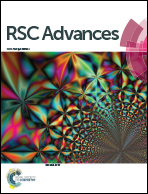Graphitic nanoparticles from thermal dissociation of camphor as an effective filler in polymeric coatings
Abstract
We report an easy synthesis of uniformly-sized water soluble graphitic-carbon nanoparticles (CNP) from the soot obtained by the incineration of camphor. The soot was characterized by X-ray diffraction (XRD) and Raman spectroscopy which reveal the presence of graphitic domains in the obtained nanoparticles. Scanning electron microscope (SEM) images display uniformly sized CNPs of about ∼50 nm. The camphoric soot was then oxidized with a piranha solution to decorate the CNP surface with a carboxyl group. This presence of carboxyl groups was confirmed by the C![[double bond, length as m-dash]](https://www.rsc.org/images/entities/char_e001.gif) O stretching at 1720.17 cm−1 in the Fourier transform-infrared spectroscopy. Following the surface treatment, CNPs were reacted with diisocyanate to form amide linkages, which were exploited in the fabrication of CNP–polyurethane hybrid composite material (CNP–PU). Minuscule incorporation (0.1, 0.5 wt%) of CNP into polyurethanes showed a magnificent improvement in the overall thermo-mechanical properties of the CNP–PU as compared to neat polyurethane films. From the XRD analysis of CNP–PU it is evident that incorporation of CNPs enhances the crystallinity of the resultant composite. Proper dispersion of CNPs into the polyurethane matrix was noticeable in the SEM images of the composite.
O stretching at 1720.17 cm−1 in the Fourier transform-infrared spectroscopy. Following the surface treatment, CNPs were reacted with diisocyanate to form amide linkages, which were exploited in the fabrication of CNP–polyurethane hybrid composite material (CNP–PU). Minuscule incorporation (0.1, 0.5 wt%) of CNP into polyurethanes showed a magnificent improvement in the overall thermo-mechanical properties of the CNP–PU as compared to neat polyurethane films. From the XRD analysis of CNP–PU it is evident that incorporation of CNPs enhances the crystallinity of the resultant composite. Proper dispersion of CNPs into the polyurethane matrix was noticeable in the SEM images of the composite.


 Please wait while we load your content...
Please wait while we load your content...